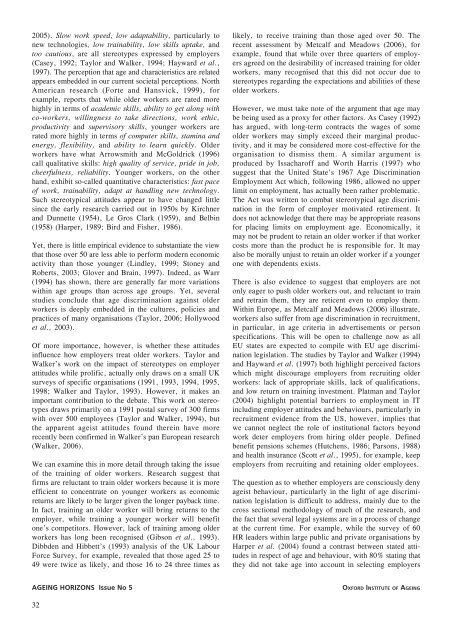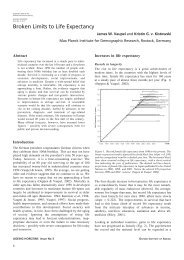download this material - Mature @ EU
download this material - Mature @ EU
download this material - Mature @ EU
Create successful ePaper yourself
Turn your PDF publications into a flip-book with our unique Google optimized e-Paper software.
2005). Slow work speed, low adaptability, particularly to<br />
new technologies, low trainability, low skills uptake, and<br />
too cautious, are all stereotypes expressed by employers<br />
(Casey, 1992; Taylor and Walker, 1994; Hayward et al.,<br />
1997). The perception that age and characteristics are related<br />
appears embedded in our current societal perceptions. North<br />
American research (Forte and Hansvick, 1999), for<br />
example, reports that while older workers are rated more<br />
highly in terms of academic skills, ability to get along with<br />
co-workers, willingness to take directions, work ethic,<br />
productivity and supervisory skills, younger workers are<br />
rated more highly in terms of computer skills, stamina and<br />
energy, flexibility, and ability to learn quickly. Older<br />
workers have what Arrowsmith and McGoldrick (1996)<br />
call qualitative skills: high quality of service, pride in job,<br />
cheerfulness, reliability. Younger workers, on the other<br />
hand, exhibit so-called quantitative characteristics: fast pace<br />
of work, trainability, adapt at handling new technology.<br />
Such stereotypical attitudes appear to have changed little<br />
since the early research carried out in 1950s by Kirchner<br />
and Dunnette (1954), Le Gros Clark (1959), and Belbin<br />
(1958) (Harper, 1989; Bird and Fisher, 1986).<br />
Yet, there is little empirical evidence to substantiate the view<br />
that those over 50 are less able to perform modern economic<br />
activity than those younger (Lindley, 1999; Stoney and<br />
Roberts, 2003; Glover and Brain, 1997). Indeed, as Warr<br />
(1994) has shown, there are generally far more variations<br />
within age groups than across age groups. Yet, several<br />
studies conclude that age discrimination against older<br />
workers is deeply embedded in the cultures, policies and<br />
practices of many organisations (Taylor, 2006; Hollywood<br />
et al., 2003).<br />
Of more importance, however, is whether these attitudes<br />
influence how employers treat older workers. Taylor and<br />
Walker’s work on the impact of stereotypes on employer<br />
attitudes while prolific, actually only draws on a small UK<br />
surveys of specific organisations (1991, 1993, 1994, 1995,<br />
1998; Walker and Taylor, 1993). However, it makes an<br />
important contribution to the debate. This work on stereotypes<br />
draws primarily on a 1991 postal survey of 300 firms<br />
with over 500 employees (Taylor and Walker, 1994), but<br />
the apparent ageist attitudes found therein have more<br />
recently been confirmed in Walker’s pan European research<br />
(Walker, 2006).<br />
We can examine <strong>this</strong> in more detail through taking the issue<br />
of the training of older workers. Research suggest that<br />
firms are reluctant to train older workers because it is more<br />
efficient to concentrate on younger workers as economic<br />
returns are likely to be larger given the longer payback time.<br />
In fact, training an older worker will bring returns to the<br />
employer, while training a younger worker will benefit<br />
one’s competitors. However, lack of training among older<br />
workers has long been recognised (Gibson et al., 1993).<br />
Dibbden and Hibbett’s (1993) analysis of the UK Labour<br />
Force Survey, for example, revealed that those aged 25 to<br />
49 were twice as likely, and those 16 to 24 three times as<br />
likely, to receive training than those aged over 50. The<br />
recent assessment by Metcalf and Meadows (2006), for<br />
example, found that while over three quarters of employers<br />
agreed on the desirability of increased training for older<br />
workers, many recognised that <strong>this</strong> did not occur due to<br />
stereotypes regarding the expectations and abilities of these<br />
older workers.<br />
However, we must take note of the argument that age may<br />
be being used as a proxy for other factors. As Casey (1992)<br />
has argued, with long-term contracts the wages of some<br />
older workers may simply exceed their marginal productivity,<br />
and it may be considered more cost-effective for the<br />
organisation to dismiss them. A similar argument is<br />
produced by Issacharoff and Worth Harris (1997) who<br />
suggest that the United State’s 1967 Age Discrimination<br />
Employment Act which, following 1986, allowed no upper<br />
limit on employment, has actually been rather problematic.<br />
The Act was written to combat stereotypical age discrimination<br />
in the form of employer motivated retirement. It<br />
does not acknowledge that there may be appropriate reasons<br />
for placing limits on employment age. Economically, it<br />
may not be prudent to retain an older worker if that worker<br />
costs more than the product he is responsible for. It may<br />
also be morally unjust to retain an older worker if a younger<br />
one with dependents exists.<br />
There is also evidence to suggest that employers are not<br />
only eager to push older workers out, and reluctant to train<br />
and retrain them, they are reticent even to employ them.<br />
Within Europe, as Metcalf and Meadows (2006) illustrate,<br />
workers also suffer from age discrimination in recruitment,<br />
in particular, in age criteria in advertisements or person<br />
specifications. This will be open to challenge now as all<br />
<strong>EU</strong> states are expected to compile with <strong>EU</strong> age discrimination<br />
legislation. The studies by Taylor and Walker (1994)<br />
and Hayward et al. (1997) both highlight perceived factors<br />
which might discourage employers from recruiting older<br />
workers: lack of appropriate skills, lack of qualifications,<br />
and low return on training investment. Platman and Taylor<br />
(2004) highlight potential barriers to employment in IT<br />
including employer attitudes and behaviours, particularly in<br />
recruitment evidence from the US, however, implies that<br />
we cannot neglect the role of institutional factors beyond<br />
work deter employers from hiring older people. Defined<br />
benefit pensions schemes (Hutchens, 1986; Parsons, 1988)<br />
and health insurance (Scott et al., 1995), for example, keep<br />
employers from recruiting and retaining older employees.<br />
The question as to whether employers are consciously deny<br />
ageist behaviour, particularly in the light of age discrimination<br />
legislation is difficult to address, mainly due to the<br />
cross sectional methodology of much of the research, and<br />
the fact that several legal systems are in a process of change<br />
at the current time. For example, while the survey of 60<br />
HR leaders within large public and private organisations by<br />
Harper et al. (2004) found a contrast between stated attitudes<br />
in respect of age and behaviour, with 80% stating that<br />
they did not take age into account in selecting employers<br />
AGEING HORIZONS Issue No 5<br />
OXFORD INSTITUTE OF AGEING<br />
32





![ORAL PRESENTATIONS [pdf] - Oxford Institute of Ageing](https://img.yumpu.com/37918222/1/184x260/oral-presentations-pdf-oxford-institute-of-ageing.jpg?quality=85)




